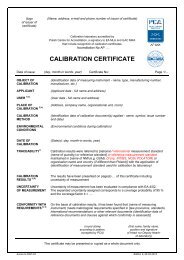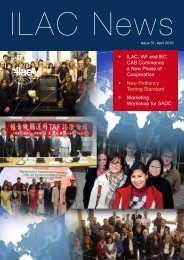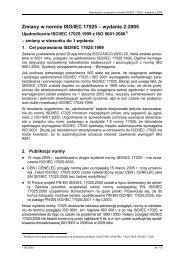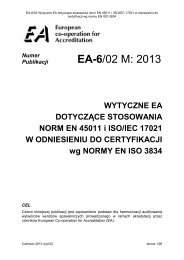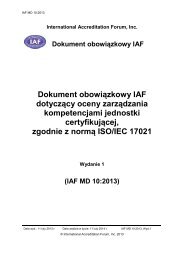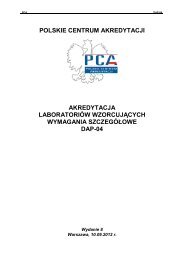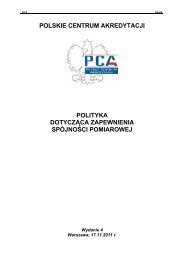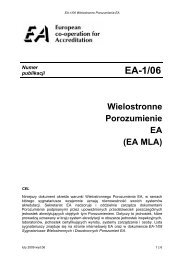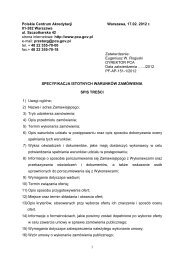ILAC News 38
ILAC News 38
ILAC News 38
- No tags were found...
Create successful ePaper yourself
Turn your PDF publications into a flip-book with our unique Google optimized e-Paper software.
The BIPM and <strong>ILAC</strong>The BIPM and <strong>ILAC</strong> continue to workclosely in areas of mutual interest,and not surprisingly both organizationsconsider close liaison as being of the highestimportance. The senior representatives ofthe two organizations met in March, anda number of ideas are being developed tostrengthen the links, and particularly tojointly promote the CPM MRA and the <strong>ILAC</strong>Arrangement. The BIPM was represented atthe AIC meeting at the end of June by AndyHenson, the new International Liaison Officerat the BIPM.50th anniversary of the SI: theInternational System of UnitsThe year 2010 marks the 50th anniversaryof the adoption of the name “InternationalSystem of Units”, and the symbol “SI” (takenfrom the French words Système internationald’unités), by the General Conference onWeights and Measures (CGPM, ConférenceGénérale des Poids et Mesures) in 1960. This11th meeting of the General Conference wasthus the formal beginning of the SI. Thesuccess of the SI in providing internationallyagreed standards for the world of science,engineering and technology is an occasion tobe celebrated.The BIPM was originally established in1875 by the Metre Convention to ensureworld-wide unification of measurements.At its 1st meeting, in 1889, the GeneralConference decided definitions of the metreand the kilogram in terms of prototypeartefacts. Definitions of the electrical unitsbased on the ampere were added at the9th meeting of the General Conference, in1948, in agreement with the IEC. At thesame conference the candela was adopted asthe name of the unit of luminous intensityin place of the older “new candle”. Thedefinition of the kelvin was added at the10th meeting of the General Conference, in1954, and the formal definition of the secondwas added by the CIPM in 1956. Finally the11th meeting of the General Conference in1960 laid the foundation for the completesystem of units, built upon the six base unitsused at that time and including multiple andsub-multiple prefixes, and adopted the nameInternational System of Units by which theentire system is known today. The definitionof the mole for the quantity amount ofsubstance, the seventh base unit, wasadded at the 14th meeting of the GeneralConference in 1971.There have been many developments tothe system during the 50 years from 1960to 2010. The definitions of many of thebase units have been revised to meet newdevelopments in the experimental basis ofmetrology, and to ensure the coherence ofthe entire system. These changes have beenfaithfully recorded in successive editions ofthe SI Brochure, prepared by the ConsultativeCommittee for Units (CCU) and published bythe BIPM at irregular intervals.The Brochure has grown from the 36 pagesof the original first edition to the 200 pagesof the 8th and current edition, published in2006. The 8th edition is also accompaniedfor the first time by the four-page ConciseSummary of the SI. These publications areavailable free at www.bipm.org and arerecognized around the world as the referencestandard for all quantitative measurements.The SI has reached maturity as the ultimateinternational reference for all standardsof measurement, but it is a living system,forever being revised and improved in avariety of ways to recognize our developingabilities in making measurements. Atpresent there are active plans to revise thedefinitions of four of the seven base units -the kilogram, ampere, kelvin and the mole- as we strive to achieve a more uniformsystem in which the definition of all unitsare referenced to the fundamental constantsof nature.Metre Convention and the CIPMMRA - interest continues to growIn addition to the signature of the CIPMMRA by the WMO (see below), the BIPM hasInternational Updateregistered three further signatories of theCIPM MRA:• The Executive Director of the GhanaStandards Board (GSB), Republic ofGhana, signed the CIPM MRA on 24February 2010. The Republic of Ghanahad become an Associate of the CGPM on17 September 2009.• The Director-General of the InstitutoNacional de Tecnologia y Normalizacion(INTN) of Paraguay, signed the CIPMMRA on 26 October 2009. Paraguay hadbecome an Associate of the CGPM on 6May 2009.• The President of the Instituto Nacionalde Defensa de la Competencia y de laProtección de la Propiedad Intelectual(INDECOPI) of Peru, signed the CIPM MRAon 17 November 2009. The Republic ofPeru had become an Associate of theCGPM on 28 May 2009.As of 18 June 2010, the CIPM MRA has beensigned by representatives of 78 institutesfrom 48 Member States, 27 Associates of theCGPM, and three international organizations,and covers a further 133 institutesdesignated by the signatory bodies as holdersof specific national standards. The full listof participants in the CIPM MRA is availablefrom http://www.bipm.org/en/cipm-mra/participation/signatories.htmlThe Republic of Kenya, previously Associateof the CGPM, became a Member State of theBIPM on 1st January 2010, and the People’sRepublic of Bangladesh became an Associateof the CGPM on 29 March 2010. This bringsthe current number of Member States of theBIPM to 54, and of Associates to 28. For thefull list, see the BIPM website.As of mid-May 2010, about 23 000 CMCswere included in the BIPM key comparisondatabase (KCDB) representing an additional1800 CMCs compared to mid-May 2009.Indeed, over the last year a large numberof newly approved sets of CMCs havebeen published. There is also a continuousmovement linked to approval of QualitySystems (QS): temporary removal (so-called“greying-out”) of CMCs not covered by anapproved QS, and re-instatement of CMCsfollowing approval of the QS. OccasionallyCMCs are also deleted permanently, if theyrelate to services that are no longer provided.Last year the KCDB attracted more thancontinued next page<strong>ILAC</strong> <strong>News</strong> | International Update 7



